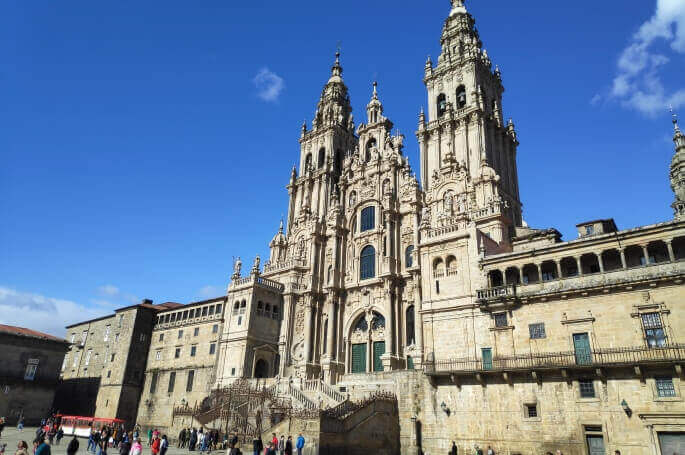Cathedral of Santiago de Compostela – History
James the Great, also known as St. James, was an apostle of Jesus Christ who introduced the Christian faith to the Iberian Peninsula in Spain. He was beheaded for his belief in Judea, and his body was brought back to Galicia, Spain. As a result of the severe persecution of Christians in Spain, his tomb was abandoned at this time.

Pelagius the hermit was said to have witnessed strange lights in the sky that led him to St. James’ long-abandoned tomb. Upon discovering Saint James tomb, King Alphonse II declared Saint James the patron of his empire. King Alphonse II had a chapel built at that location in 819 AD. This church was ruined by Al-Mansur’s Moorish army in 997. Al-Mansur left the Apostle’s tomb and surrounding relics undisturbed. Construction on a new cathedral began in 1060 and concluded in 1211. The original chapel became the cathedral of the new settlement, Santiago de Compostela.
The cathedral is a key point in the Way of Saint James going back to the early middle ages. It marks the end of the historic Camino de Santiago route.
In the 12th and 13th century the town developed great importance. Pope Alexander III declared it a Holy Town, like Rome and Jerusalem. Pope Calixto II declared pilgrims who went to Santiago in a Holy Year should be free of all their sins. El Año Santo (Holy Year) is celebrated when the Apostol’s day (July, 25) is on a Sunday.
Learn more: Download your FREE Camino e-book!
Discover the routes and sections of the famous Camino de Santiago pilgrimage.
DownloadCathedral of Santiago – Architecture
The most impressive piece of architecture in Santiago de Compostela is its Cathedral. One of the main attractions of this cathedral is the 12th-century Portico de la Gloria. It has become significant for pilgrims walking the Camino to reach this cathedral at the end of their journey along the Camino de Santiago. One of the three rituals that pilgrims perform on arrival is to touch a certain place on the column. A groove has been worn into the stone due to so many pilgrims resting their hands here. Other outstanding highlights of the cathedral are the two towers, which were built over a span of a few hundred years.
The Various Styles
Various elements were added and taken away through different time periods. Overall, the exterior of the cathedral remains primarily Romanesque-style, but the exterior façade is Baroque. The exterior of the cathedral known as the Obradoiro façade is composed of granite and depicts statues of Saint James.
The Interior
Inside, the altar showcases different influences from varying time periods. It depicts gothic aspects as well as 18th-century influences. The relics of St. James are located behind the altar in the cathedral and can be viewed from the crypt.
The Botafumeiro
A notable part of this cathedral is the Botafumeiro which dispenses clouds of incense through the use of a pulley mechanism. This is the largest censer in the world with a weight of 80 kg and a height of 1.60 m. Eight tiraboleiros clad in red robes pull the ropes and bring it into an intensely quick swinging motion.
The cathedrals Chapel of the Reliquary (Capilla del Relicario) houses a gold crucifix said to contain a piece of the True Cross.
The Plazas
There are many plazas & squares in the city to visit, but the most popular ones are clustered around the cathedral of Santiago. The Plaza del Obradoiro is the gathering place for pilgrims during the feast day of St. James. The name of this square is said to come from “Obra de Oro” (work of gold). It forms the center of the town.
Other Attractions
Another major architectural attraction in Santiago is the Rajoy Palace, which faces the cathedral on El Obradioro Square. The four-story granite building has an arched walkway, central columns and a triangular neo-classic feature of the apostle St. James.
If you have any questions on the Camino de Santiago tours, then please don’t hesitate to contact us at info@followthecamino.com
Sources:
https://en.wikipedia.org/wiki/Santiago_de_Compostela_Cathedral
http://www.sacred-destinations.com/spain/santiago-cathedral





 Flexible itineraries
Flexible itineraries  Luggage transfers
Luggage transfers  Private rooms & bathrooms
Private rooms & bathrooms
